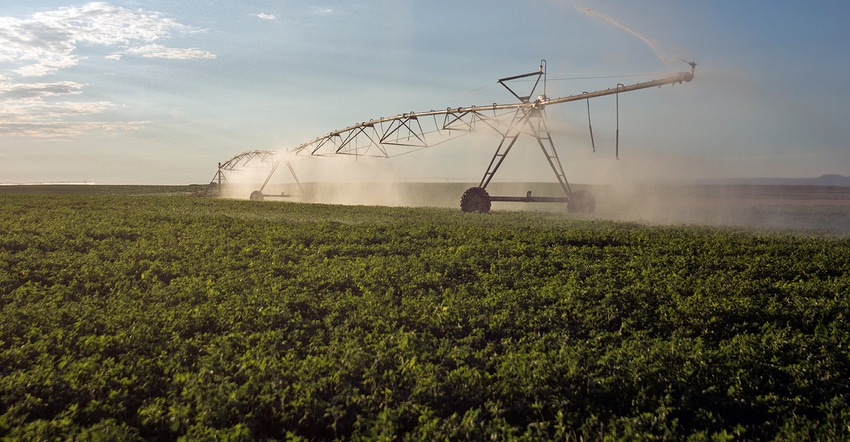October 17, 2018

Cameron Gulleson, Rutland, N.D., has had good luck with variable rate irrigation (VRI).
He's saved money, improved corn and soybeans yields and protected water quality.
"That's a win-win-win," says Cameron, who farms with his wife, Jennifer; his brothers, Lance and Cody, and their wives, Natalie and Hannah; and his parents, Bill and Pam Gulleson.
VRI involves applying water at many different rates along a center pivot rather than one single rate along its entire length.
As with variable rate seeding or variable fertilizer application, Global Positioning System and Geographic Information System technology is combined with yield and soil maps and other information to prescribe a specific amount of water be applied in certain areas of the field.
VRI equipment can shut off water to nozzles and deliver much as 200% of the normal application rate of water to other nozzles by the opening or closing of individual nozzles and speeding up or slowing down of the pivot.
The 133-acre field that Cameron selected for VRI is hilly and had many different soil types, making it difficult to efficiently irrigate with a system that applied the same amount of water from one end of the pivot to the other. The Gullesons apply fertilizer and crop protection chemicals through the irrigator, too. In some places, the pivot put on too much water and nutrients, and in other places it didn't put on enough. The field also included two non-farmed wetlands covering about 35 acres that didn't need to get any additional water, and definitely not any of the fertilizer.
In 2016, the Gullesons retrofitted a pivot to VRI. The equipment that was changed or added consisted of valve controllers, drop tubes, pressure regulators, nozzles, variable frequency drive pumps and electronic flow meters.
The USDA Natural Resources Conservation Service provided technical assistance and cost sharing for the project. VRI qualifies for cost-sharing through the Environmental Quality Incentives Programs (EQIP) if the field contains soil conditions, topography or non-farmed areas that cause significant over- or underapplication of water or nutrients, says Erica Althoff, USDA Natural Resources Conservation Service area agricultural engineer, Jamestown, N.D.
One of the most important aspects of VRI is the irrigation water management after the structural components are installed, Althoff says.
New soil probes were installed in Gulleson's field to help Cameron determine when to irrigate. He had to adjust the prescription a couple of times after they started the pivot because soil moisture probes showed that, below the 16-inch depth, the soil in some areas was always dry. An NRCS soil scientist probed the field to the 40-inch depth and found there were many different layers of soil types mixed throughout the field.
Cameron used the new data to alter the prescription. He programmed the pivot to put on less water each time, but to water more frequently to keep the soil in the top 16 inches moist while the plants were small.
The VRI system worked flawlessly after the adjustment, Cameron says. He physically checked the pivot as usual during the growing season and was also able to monitor and control the pivot from his smartphone. He could also get soil moisture data on his phone.
The corn averaged 58 bushels per acre more in 2016 with VRI than in 2013 without VRI. The years were different for growing corn, but Cameron attributes some of the increase to the VRI. The electric bill was $2,000 for the season, compared to $4,500 for the previous year. The quality of the water in the wetlands was protected because water and fertilizer wasn't applied over the non-farmed areas.
"It's very exciting technology and NRCS was a great help," Cameron says. "I am really pleased with how the project turned out."
The retrofitted pivot is 40 years old. "We now have the oldest smart pivot out there," Cameron says.
VRI cost sharing
In North Dakota, NRCS helped convert four pivots to VRI in 2016 and 10 pivots in 2017. In 2018, there were 29 applications for VRI cost sharing. Twenty will get funding to install VRI equipment in 2019.
Apply early for assistance because information has to be gathered from the field to determine whether the project will qualify for EQIP cost sharing.
"NRCS is looking for water savings, energy savings and improved water quality," Althoff says.
For more information, contact your local NRCS office or Althoff at 701-658-3352 or [email protected].
You May Also Like




